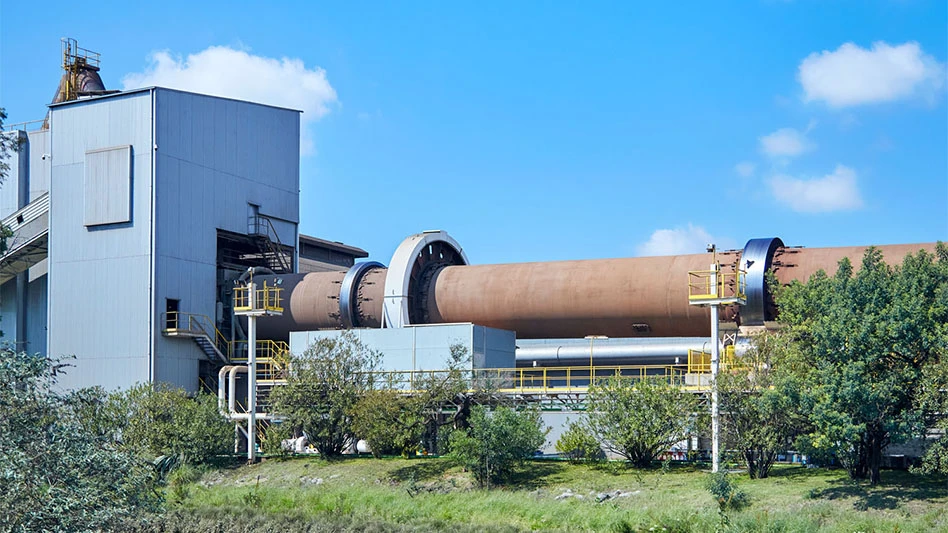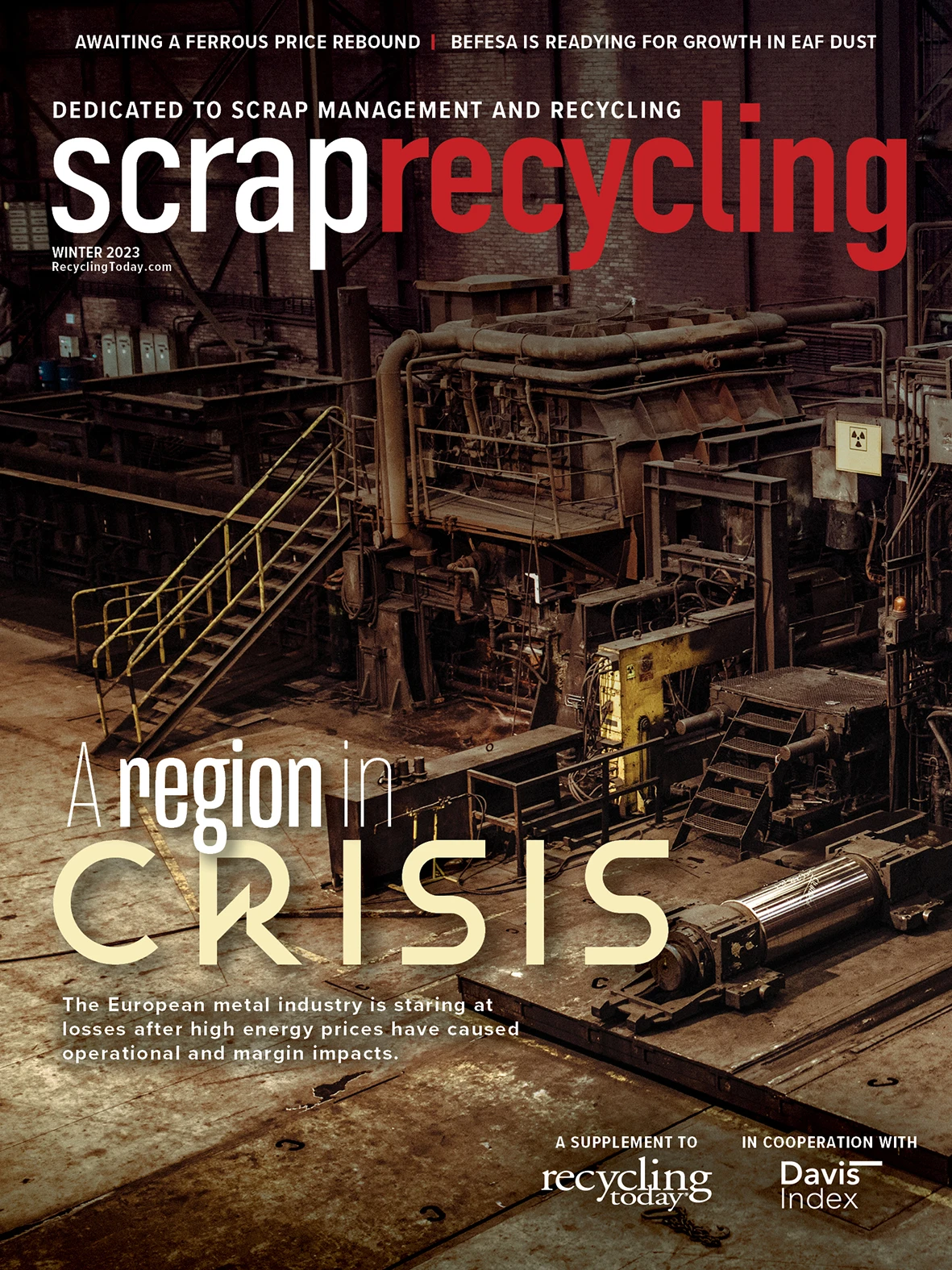

When Befesa S.A. was listed on the Frankfurt Stock Exchange in 2017, the company made several promises to its shareholders. Javier Molina, executive chair of the Luxembourg-based company, says he believes Befesa has lived up to those promises and is poised to further benefit from the decarbonization trend.

Molina says the company, which recycles hazardous waste and residues produced during steel and aluminum production, has delivered on the growth it promised in 2017, primarily through its 2021 acquisition of Pittsburgh-based American Zinc Recycling and by entering the Chinese market with the completion of its first electric arc furnace dust (EAFD) recycling plant in Changzhou in 2020. Befesa has a second plant in Xuchang in the Chinese province of Henan that it began constructing in 2019 shortly after breaking ground on the Changzhou site. Both sites can recycle up to 110,000 tons of EAFD per year.
“We are very proud of what we have achieved—especially over the past 10 years—growing Befesa from a European-focused company to the international leading company in hazardous residues recycling services for the steel and aluminum industry,” Molina says.
In addition to growing its footprint outside of Europe since 2017, he says Befesa has become a leader in the environmental, social and governance (ESG) area and the circular economy. “We improved our health and safety rate by 85 percent over the past five years and our operations help to avoid more than a million tons of CO2 equivalent each year,” Molina says.
The company’s origin dates to 1987 when Berzelius Umwelt Service (BUS) was created by Metallgesellschaft, a German industrial conglomerate. In 1993, BUS grouped its Spanish assets into Berzelius Felguera (Befesa), which acquired the remaining stake in BUS in 2006, becoming what Molina calls the European leader in EAFD recycling.
Befesa entered Turkey through a joint venture with Silvermet in 2010 and the Asian market in 2012 with a plant in Gyeongju, South Korea, originally in partnership with Hankook Steel Co. Ltd. However, Befesa only recently entered the U.S. market, where approximately 70 percent of steel is produced using scrap-fed EAFs.
Entering the United States
Befesa acquired American Zinc Recycling (AZR) for $450 million in 2021. The purchase of AZR increased Befesa’s total steel dust recycling capacity by 40 percent to 1.7 million tons at 12 facilities in Europe, Asia and the United States. Acquiring AZR provided Befesa with its first North American operations and “a significant and well-developed presence in the growing EAF steelmaking markets” in the U.S., the company said at the time of the AZR purchase.
In addition to the AZR acquisition, Befesa invested $10 million for a joint venture minority stake in American Zinc Products (AZP), AZR’s zinc refining operation in Rutherford County, North Carolina. Befesa completed its purchase of AZP in October 2022 when it acquired the remaining 93 percent stake in the company.
When it announced its purchase of AZP, Befesa said it used the macroeconomic environment, characterized by high inflation and energy prices, to renegotiate the terms and conditions of the agreement, thereby reducing the acquisition price by 65 percent to $47 million from $135 million.
The zinc refining facility in North Carolina is centrally located between Befesa’s U.S. recycling assets in Palmerton, Pennsylvania; Barnwell, South Carolina; Rockwood, Tennessee; and Calumet, Illinois. The plant applies new solvent extraction technology to process the waelz oxide, or WOX, Befesa produces into what it calls a “special high-grade zinc.”
The zinc refining business enables Befesa to support its EAFD recycling operations in the U.S. by addressing what it calls a shortage of smelting capacity in the North American market. It has the capacity to produce approximately 140,000 tons of high-grade zinc per year and is the only facility of its kind in the world producing “green” zinc from 100-percent-recycled raw materials, the company says.

People and technology
The acquisition of AZP increased Befesa’s workforce to 1,900 employees globally across 26 facilities.
“What is very important is our people,” Molina says, from the “very stable and experienced senior leadership team” to “everyone across all functions and all plants.” He adds, “We are very proud of our talent.”
Befesa’s team invented its recycling technologies for EAFD recycling. “On the steel dust side, it’s waelz kiln technology,” Molina says.
Befesa acquired the German company that developed the aluminum salt slags recycling technologies, Agor AG, in 2009.
“We continue to develop these technologies further and further, hold various patents, have a dedicated operational excellence engineering team which collaborates with various leading universities to ensure that we stay ahead of the game in terms of process technology and efficiency,” Molina says.
Befesa says one of the pillars of its research and development strategy is this external collaboration, primarily via research groups and institutions, public research centers, universities and other industrial enterprises.
Several of the company’s facilities have been designed to process 110,000 tons (110 kt) annually using the “latest state-of-the-art design,” Molina says, including two the company operates in South Korea. “We have upgraded our Turkish facilities to 110 kt, and our two new plants in China also follow this layout. It is our design; we outsource the construction itself to a turnkey construction company.”
In addition to its technology and talent focus, Molina says Befesa’s culture is characterized by a compliance mindset. “We have established very rigorous and consistent compliance policies all around the world,” he adds.
Befesa also values its customer relationships, with Molina saying the company grows its service operations with and for its customers.
Being of service
Befesa primarily services the steel and aluminum industries, recycling more than 2 million tons of hazardous residues annually to extract and produce more than 1.5 million tons of resources, primarily zinc, aluminum and salt, Molina says.
“We have historically focused on environmental services to the steel and aluminum industries, and, within those, mostly on the secondary steel and aluminum side,” he says. “This means we work with the steel and aluminum producers that use steel and aluminum scrap as input for the production of new steel and aluminum in their recycling operations.”
Befesa primarily handles EAFD. “For each ton of electric arc furnace steel produced, our customers generate 15 to 20 kilograms of a hazardous byproduct called EAFD,” Molina says.The WOX Befesa produces is sold to any of the global zinc smelters, such Glencore, Korea Zinc or Nyrstar, he says. In the U.S., this material can go to its newly acquired refining operation.
For its aluminum customers, the company primarily processes salt slags, with customers generating nearly 400 to 500 kilograms in the production of 1 ton of aluminum, Molina says.
“On the aluminum side, we service the major European aluminum players and also sell to the European aluminum industry players, such as Hydro, Trimet or Novelis,” he adds.
Befesa receives a collection fee for each ton of hazardous waste it manages for its customers in the U.S. and Europe.
The company has more than 1.5 million tons of EAFD recycling capacity globally, Molina says, with 450,000 tons of aluminum salt slags and spent pot lining capacity and 200,000 tons of secondary aluminum recycling capacity in Europe.
Befesa achieved 225 million euros ($237.5 million) in earnings before interest, taxes, depreciation and amortization (EBITDA) for the last 12 months trailing as of November 2022, with 80 percent coming from its steel industry services and 20 percent from the environmental services it provides to the aluminum industry, he adds.

Growth outlook
While Molina says 2022 was a challenging year given the macroeconomic developments, Befesa is on track to deliver record results as of November. “We were able to offset inflationary pressures such as energy costs through improved metal prices for zinc and aluminum. What drove our 20 percent year-over-year EBITDA increase in the first nine months was volume—mainly thanks to the contribution of our U.S. operations,” he says.
Molina says Befesa entered 2022 “in probably the best shape that we’ve ever been in,” largely because of its long-term and efficient capital structure, its use of commodity hedging and its cash management, liquidity and leverage. “Even after just having acquired a U.S. zinc refining asset for $47 million and having paid 1.25 euros per share dividend in Q3, we still have liquidity of more than 200 million euros.”
In the area of hedging, Molina says, “We sell 60 to 75 percent of the zinc forward at fixed prices for the next one to three years, which ensures stability of earnings and cash flow. The risk is transferred entirely, as we do not provide any collateral, and this way we lock in our earnings and cash flow in a much tighter bandwidth for the coming years.
“All this has served us well in the past and ensures that we can self-fund our five-year ‘Sustainable Global Growth Plan.’”
Molina says Befesa is looking forward to the next five years as the megatrends of decarbonization and the transition to electric vehicles will drive its customers’ growth. “And Befesa will grow with its customers as a reliable service partner.”
Befesa hosted its first capital markets day with its investors in November 2022, clarifying its growth path. Molina says the firm will invest as much as 450 million euros ($478 million) in capital expenditures.
With U.S. EAFD generation expected to increase by more than 0.3 million tons by 2030, Befesa plans to increase capacity utilization at its U.S. plants through 2026, targeting 200,000 tons of incremental throughput, according to its capital markets day presentation. The company plans to refurbish its Palmerton site in 2023 to be ready for the expected volume increase.
In Europe, Befesa says it plans to add up to 160,000 tons of EAFD recycling capacity to maintain its 45 percent market share as EAFD generation grows.
Approximately 60 million tons of new EAF capacity have been announced in China, representing roughly 1 million tons of EAFD generation. Befesa plans to add three new facilities, each capable of processing 110,000 tons, increasing its market share to as much as 20 percent.
Befesa says automotive demand for aluminum will continue to grow to address light-weighting needs, while original equipment manufacturers will seek to reduce their carbon footprints by using recycled metal. The company forecasts a 300,000-ton increase in salt slags generation in Europe by 2030 as a result and will invest to expand its secondary aluminum production capacity by 90,000 tons in Bernburg, Germany, and invest in a new 120,000-ton salt slags recycling plant.
“We have successfully grown through the past few cycles, and, based on the decarbonization and EV trend paired with our industry-leading position, we are really looking forward to the next five years,” Molina says.

Explore the Winter 2023 Scrap Recycling Issue
Check out more from this issue and find your next story to read.
Latest from Recycling Today
- BMW Group, Encory launch 'direct recycling’ of batteries
- Loom Carbon, RTI International partner to scale textile recycling technology
- Goodwill Industries of West Michigan, American Glass Mosaics partner to divert glass from landfill
- CARI forms federal advocacy partnership
- Monthly packaging papers shipments down in November
- STEEL Act aims to enhance trade enforcement to prevent dumping of steel in the US
- San Francisco schools introduce compostable lunch trays
- Aduro graduates from Shell GameChanger program





